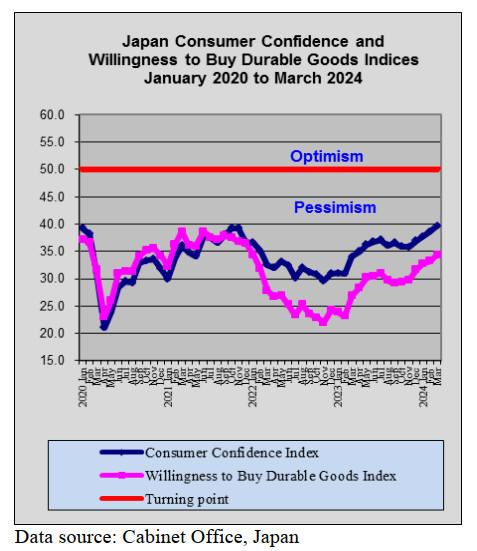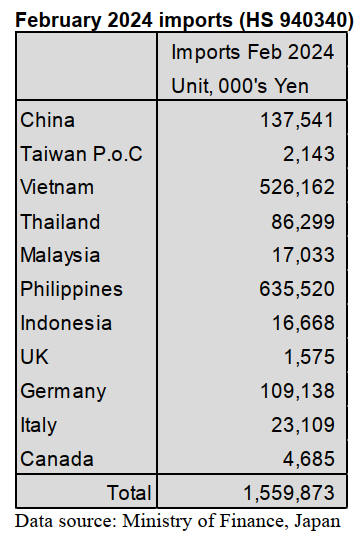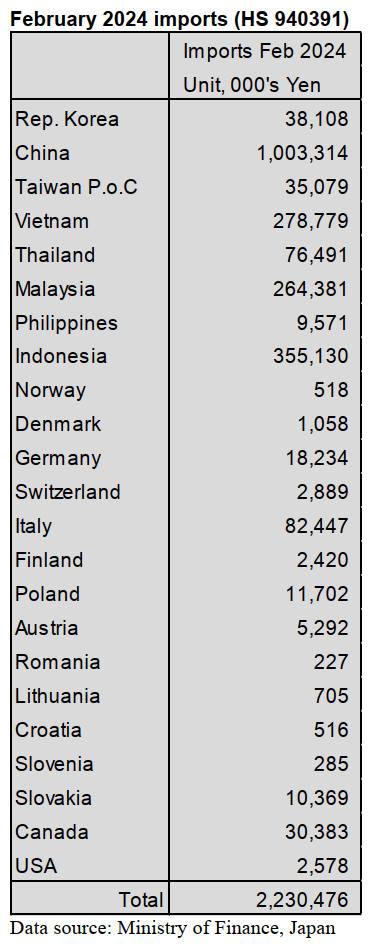Japan
Wood Products Prices
Dollar Exchange Rates of 10th
May
2024
Japan Yen 156.22
Reports From Japan
Rapid growth to lift
India’s GDP beyond Japan’s
According to forecasts from the International Monetary
Fund, India will overtake Japan in nominal gross domestic
product (in dollar terms) in 2025. Japan's nominal GDP in
2025 is forecast to reach US$4.31 trillion while India's is
expected at US$4.34 trillion. The timing of India's GDP
surpassing Japan's is a year earlier than the IMF projected
last October, reflecting the yen's steady depreciation.
If the forecast is correct, the Japanese economy will fall to
the fifth largest in the world. Behind the rise of India is not
only the weaker yen but also India’s rapid economic
growth driven by huge domestic demand as its population
is believed to have surpassed China's in 2023 and the
steady inflow of investment.
See:
https://www.japantimes.co.jp/news/2024/04/28/japan/india-japan-economies/
Labour pool continues to shrink
Private sector survey data compiled by Teikoku Databank
and published in the Japan Times reveals that over 50% of
the companies in the survey consider the labour shortage a
serious issue as they are finding it increasingly hard to find
enough employees.
As the labour pool continues to shrink companies say
labour shortage are one of their biggest concerns. Data
compiled by Teikoku Databank showed that out of the
over 27,000 companies surveyed in April, labour shortages
were most notable in the field of information technology
engineering.
See:
https://www.japantimes.co.jp/business/2024/05/06/economy/labor-crunch-continues-in-japan/
SMEs struggle to pass on rising labour costs
Reports in the domestic media say, according to a recent
survey, about 70% of companies in Japan will implement
pay scale increases in fiscal 2024 but for small and mid-
sized firms the number was much lower which is
unfortunate as these companies are the main employers in
Japan.
The Ministry of Finance survey found half of the small
and mid-sized firms said that they had been unable to pass
on rising labour costs. In addition, the survey found about
40% of all firms were struggling with labour shortages
even after raising wages.
According to the Tankan quarterly business sentiment
survey released by the Bank of Japan large manufacturer’s
business sentiment in March worsened for the first time in
the past four quarters.
See:
https://japannews.yomiuri.co.jp/business/economy/20240423-182000/

Several currency interventions suspected
The yen strengthened to 153.10 to the dollar at its peak on
8 May after the US Federal Reserve decided to keep
interest rates steady. The rally came after the yen was
trading close to 158 yen per dollar earlier the same day.
Financial data released by the Bank of Japan suggests that
the Japanese government possibly injected 3 trillion yen
(US$19 trillion) into currency markets to prop up the yen.
Former US Treasury Secretary, Lawrence Summers,
commented that currency interventions are generally
ineffective at shifting exchange rates in the long term,
even at the large magnitude that Japan has been thought to
have deployed recently.
See:
https://asia.nikkei.com/Business/Markets/Currencies/Yen-s-surge-after-Fed-announcement-stirs-fresh-intervention-talk

Vacant homes top 9 million
According to the Ministry of Internal Affairs and
Communications the number of vacant houses in Japan
rose to a fresh record of 9 million in 2023, up 510,000
from the previous 2018 survey and representing 14% of all
houses in the country, also a record-high.
The increase in vacant homes, known as’ akiya’ in
Japanese, can be attributed to cases where properties are
left unattended because single elderly dwellers die or enter
nursing homes, while individuals who inherited the
properties opt to live in more convenient locations,
according to the ministry.
The latest figure puts more pressure on central and local
governments to take measures to demolish or reuse such
uninhabited properties. The disadvantage to those
inheriting an old family home and considering
demolishing it is that vacant land attracts higher taxes in
Japan than land with buildings which adds to the financial
burden of knocking down old houses.
However, there is growing interest among foreigners in
this glut of empty properties,
particularly kominka (traditional) houses as an option for
cheap and unusual accommodation, holiday homes or to
rent out to tourists.
See:
https://japantoday.com/category/national/Number-of-vacant-homes-in-Japan-tops-record-9-mil

Enforcement of new law for decarbonised society
On 16 April, 2024 the Japanese government approved a
Cabinet decision that the new law for the decarbonised
society will be enforced as of 1 April, 2025.
According to the local media this will include 20 trillion
yen (US$137.4 billion) available for decarbonisation
support to encourage companies to participate in the
emissions trading system (ETS).
Private sector company participation in the ETS, which
began on a trial basis in Japan last year, is still optional but
the government will make participation a requirement for
companies to receive its financial support for going
greener.
The government will establish industry-specific guidelines
for reducing greenhouse gas emissions with a view to
setting targets. It will also consider providing guidance
and recommendations to companies that fail to meet their
targets based on these guidelines from fiscal 2026, when
the ETS comes into full effect.
Companies will be able to set their own reduction targets
based on ministry guidelines. Whether the targets are
appropriate or not will be subject to certification by a
third-party organisation. Currently, companies are free to
choose whether or not to participate in the ETS and can set
reduction targets on a voluntary basis. The Ministry will
not mandate participation even after fiscal 2026 but will
establish a mechanism to encourage participation in the
programme.
See:
https://asia.nikkei.com/Spotlight/Environment/Climate-Change/Japan-to-encourage-companies-to-participate-in-emissions-trading

In February 2024 the yen exchange was 150 against
the
US dollar. The continued decline in the exchange rate has
pushed up the cost of imports such that the rising trend in
the value of imports appears entirely the result of the
exchange rate.
February wooden office furniture imports (HS 940330)
China and Malaysia were the top two shippers of wooden
office furniture (HS940330) to Japan, accounting for over
90% of total February arrivals.

The value of exports of HS940330 from China to
japan in
February declined 14% month on month and shipments
from Malaysia fell sharply (-70%) compared to the value
of January shipments.
The other significant shipper of HS940330 in
February
was the Philippines.
Year on year the value of Japan’s imports of wooden
office furniture almost doubled in February but compared
to a month earlier the value of imports dropped slightly.
February 2024 kitchen furniture imports (HS 940340)
February marked the reversal of the three month decline in
the value of wooden kitchen furniture (HS940340) imports
into Japan.
Year on year the value of imports of HS940340 in
February rose with all the top shippers, the Philippines,
Vietnam and China recording increased shipments. In
addition to these three shippers exporters in Germany
managed a six fold increase in shipments of wooden
kitchen furniture to Japan in February.
Shippers in the Philippines, Vietnam and China accounted
for 83% of the value of February arrivals of wooden
kitchen furniture and all recorded month on month
increases in the value of shipments.
In previous months Thailand was among the top shippers
but the surge in imports from Germany pushed Thailand to
the 5th ranked supplier in February.

February 2024 wooden bedroom furniture imports
(HS
940350)
After five consecutive monthly increases in the value of
wooden bedroom furniture (HS930350) the value of
February imports cooled coming in at around the same
total value as January imports.

A plausible explanation for the rise in bedroom
furniture
imports over the past months is demand in the hospitality
sector.
The other factor could be the need for households to
replace furniture damaged or destroyed in the spate of
natural disasters in the country especially the earthquake
and tsunami which destroyed thousands of homes in the
Noto Peninsula.
Over 95% of the wooden bedroom furniture imported into
Japan in February was from China and Vietnam. February
arrivals from China were down from levels in January
while arrivals from Vietnam rose as did arrivals from
Malaysia.
February 2024 wooden furniture parts imports (HS
940391)
There was a further slight up-tick in the value of wooden
furniture parts (HS940391) imports into Japan in
February.

Asian suppliers topped the list accounting for over 85% of
the total value of arrivals. In addition there was a wide
range of supply countries especially in Europe with
Germany and Italy at the top.
In February China was the main supplier followed by
Indonesia but these two top shippers accounted for only
around 65% of all shipments and both saw the value of
February shipments decline compared to a month earlier.
In contrast, shipments from Vietnam were higher in
February than in January while shipments from Malaysia
were little changed month on month.
Year on year, the value of Japan’s imports of wooden
furniture parts in February was slightly higher than in
January.
Trade news from the Japan Lumber Reports (JLR)
The Japan Lumber Reports (JLR), a subscription trade
journal published every two weeks in English, is
generously allowing the ITTO Tropical Timber Market
Report to reproduce news on the Japanese market
precisely as it appears in the JLR.
For the JLR report please see:
https://jfpj.jp/japan_lumber_reports/
Enforcement of new law for decarbonised society
On 16th April, 2024, the Japanese government passed a
Cabinet decision that the new law for the decarbonised
society will be enforced as of 1st April, 2025. The new
law for the decarbonised society is that buildings with its
floor areas less than 10 square meters is not admitted to
the Energy Conservation Standards.
Rules of structures, such as‘Thickness of posts and an
amount of walls’, will be legislated because the solar
panels will be used for wooden structures. Office work of
building officers in the 47 prefectures of Japan and
municipalities will be revised.
Plywood
The situation of domestic softwood plywood has been
changed because several major plywood manufacturers
raised the price of plywood.
The price of structural softwood plywood had been low
because there were less orders to precutting plants and the
movement of plywood was sluggish in January to
February, 2024. However, Nisshin Group, Seihoku
Corporation and Hayashi Plywood Industrial Co., Ltd.
announced about the price hike of plywood as of April,
2024.
Some reasons for the price hike are the increased
distribution costs, labor costs, and subsidiary materials
costs. The price of structural plywood would exceed 1,300
yen, delivered per sheet in the future. In the middle of
March, several consumers purchased structural softwood
plywoo and several distributors sold a lot of plywood due
to the fiscal year-end in March. The price of 12 mm 3 x 6
structural softwood plywood was 1,250 yen, delivered per
sheet at the end of March.
Plywood manufacturers in Indonesia expect to raise the
price of plywood to Japanese buyers due to less logs in
Indonesia. 2.4 mm 3 x 6 costs around US$950, C&F per
cbm in South Asia.
3.7 mm cost around US$880, C&F per cbm. 5.2 mm costs
around US$850, C&F per cbm. 12 mm 3 x 6 structural
plywood costs US$560 – 570, C&F per cbm. Coated form
plywood costs around US$580, C&F per cbm. 12 mm 3 x
6 painted plywood for concrete form costs around
US$650, C&F per cbm.
In March, since the yen was continuing to depreciate
against the dollar, some major South Asian shippers
offered plywood for US$660 – 670, C&F per cbm. This is
US$10, C&F per cbm lower than the previous month.
Once, the yen depreciated to 160 yen against the dollar at
the end of April so Japanese buyers hesitated to sign
futures contracts.
The market price of South Sea structural plywood, South
Sea painted plywood for concrete and South Sea plywood
declined at the end of March. However, trading companies
announced the price hike of South Sea plywood as of
April. Now, the price of 12 mm 3 x 6 South Sea painted
plywood for concrete form is 1,950 yen delivered per
sheet. Structural plywood is 1,750 yen, delivered per
sheet. 2.5 mm plywood is 780 yen, delivered per sheet. 4
mm plywood is 1,000 yen, delivered per sheet.
5.5 mm plywood is 1,170 – 1,200 yen delivered per sheet.
Domestic logs and lumber
The price of domestic lumber is steady with a downward
tendency. Movement of domestic lumber was expected to
rise in April but it did not. Imported lumber was in short
supply and the price of imported lumber rose. Then,
lumber plants controlled production to balance demand
and supply.
As a result, there were not enough lumber at the market at
the end of March. However, there was not actual demand.
Even though, the price of lumber was lowered, consumers
would not purchase a lot of lumber so the price of lumber
leveled off at the market in many places.
In the southern part of Kanto region, KD cedar post is
around 55,000 yen, delivered per cbm. In the northern part
of Kanto region, KD cedar post is around 50,000 – 53,000
yen and this is 2,000 – 3,000 yen lower than the previous
month.
A cedar log for posts is 15,000 yen, delivered per cbm in
the northern part of the Kanto region, Kyushu area and
Tokai region. In Akita Prefecture, a cedar log for posts is
over 15,000 yen, delivered per cbm because Chugoku.
Lumber Co., Ltd.’s plant in Akita Prefecture started an
operation and demand for logs expanded. Ccypress log for
posts in Tokai region is 22,000 yen, delivered per cbm. In
Kyushu region, it is 21,000 yen, delivered per cbm.
In Chugoku region, 19,000 yen, delivered per cbm. These
prices are higher than the previous year.
Movement of small sized lumber is firm but movement of
structural lumber is dull. The selling price of lumber is low
so it is hard to get enough profits.
Hardwood log market in Hokkaido Prefecture
A hardwood log market was held in Asahikawa city,
Hokkaido Prefecture on 19th April, 2024. Volume of
hardwood logs at the market reached a level of 3,000 cbms
for the first time in five years.
Many lumber manufacturers and plywood manufacturers
did not purchase a lot of softwood logs because they have
been reducing products and the plywood price has been
falling. However, the price of hardwood logs is high so
loggers motivated to cut down a lot of hardwood trees.
Moreover, there had been enough space to put hardwood
logs at the market because it did not snow much in this
winter.
Volume of hardwood logs was 3,028 cbms at the market.
Usually, volume of hardwood logs in Hokkaido Prefecture
increases from the end of the year to next spring. It is easy
to deliver logs in this period because the ground and the
roads become hard by cold weather. Also, it is good for
logs because the cold weather keeps logs fresh. Many
buyers expect to purchase good quality logs at the market
during January to March.
There were several kinds of hardwood logs, such as Oak
logs and ash logs, at the market and the price of hardwood
logs were high. On the other hand, the price of softwood
logs such as larch logs, were low. The average unit price at
this market was 51,200 yen, per cbm and this is 12,400
yen, per cbm less than March. It was 63,600 yen, per cbm
in March. The reason is that qualities of hardwood logs
were not good enough.
New labeling system for export lumber
Japan Wood Products Export Association will enforce a
Japanese wood products export labeling system within this
fiscal year. Japan Wood Products Export Association held
information sessions about the new system in Japan and
overseas last year. Many Japanese exporters and foreign
buyers were interested in the new system very much.
The new system is to proof that lumber is made of
Japanese timber and is manufactured in Japan. Moreover,
when clients apply for a Japan Wood Products Export
Association’s logo, quality of lumber and management
system of the manufacturer will be checked. By putting a
label of ‘JAPAN WOOD’ on the lumber, it is reliable
lumber and it will strengthen Japanese brand. Also, it will
be easy for clients in overseas to find Japanese lumber.
Japan Wood Products Export Association will manage the
label.
It is able to put the label for lumber, veneers, and thin
boards, which are made of 100 % Japanese timber. Other
products are plywood, laminated lumber, LVL, furniture,
and daily use items, which consists 50 % of Japanese
timber. Japanese timber must be based on the Clean Wood
Act and logs must be cut down legally.
Establishment of private organisation in northern
Kanto region
There are ten domestic lumber companies in the northern
part of Kanto region and they will jointly receive orders.
Since they work together, they will be able to respond
several kinds of needs from customers.
The ten domestic lumber companies are
Ninomiyamokuzai Co., Ltd. in Tochigi Prefecture,
Tochimou Wood Industry Co., Ltd. in Tochigi Prefecture,
Miya Seizaisyo LLC. in Tochigi Prefecture, Watanabe
Seizaisyo Co., Ltd. in Tochigi Prefecture, Maruhachi LLC.
in Tochigi Prefecture, Yagisawa Inc. in Tochigi
Prefecture, Morishima Ringyo LLC. in Ibaraki Prefecture,
Ltd. Nogami sawmill in Ibaraki Prefecture, Hokota
Seizaisyo Co., Ltd. in Ibaraki Prefecture and Minakawa
Seizaisho LLC. in Ibaraki Prefecture. They established a
private organization.
All those companies are famous lumber companies in
Tochigi Prefecture and Ibaraki Prefecture. Each company
has its specialty. For example, one of the companies is
good at mass production and the other company is good at
producing small to large lumber, KD cypress / cedar posts,
interior construction materials, decorative laminated sheet,
JAS lumber and so on. Total log consumption of the ten
lumber companies will be 250,000 cbms annually.
The reason for establishing the private organization is that
Ninomiya mokuzai had an increase in orders for KD cedar
beams / posts and interior construction materials and the
company could not accept the all the orders.
The private organization will also host study groups
for
young executives and young successors of the companies
with architectural design firms and local forestry.
|